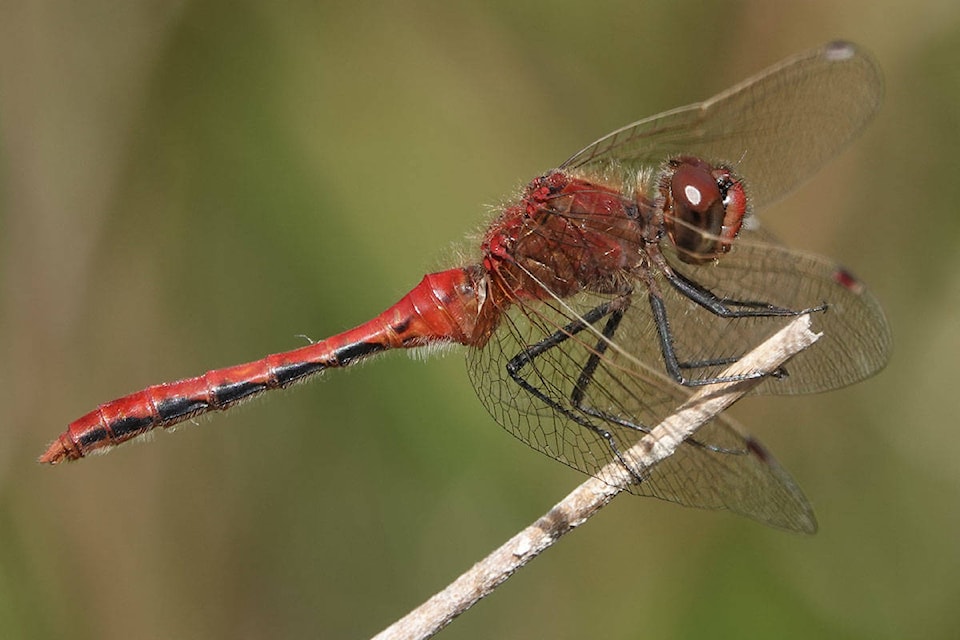With powerful wings, iridescent bodies, a voracious appetite and ancient lineage, the dragons of the Yukon are all around us – if you’re paying attention.
Biologist Syd Cannings does, and he’s inviting Yukoners to join him on Sunday to find and identify some of the territory’s most impressive flying insects: the dragonfly.
Like birding, spotting species of “Odonata”, the insect order which includes both the dragonfly and the damselfly, is a recognized hobby around the world.
As birding has become more popular during COVID-19, so has tracking down “odes.”
“It became a kind of a thing back in the 80s or 90s when dragonfly watching kind of took off, at least in Europe,” he explained. “It wasn’t a major thing, but a lot of birders in Europe decided they’d seen all the birds of England, which aren’t that many, and then there’s this whole new group of things that are kind of like birds. They’re colourful, and they’re relatively big and they fly in the daytime, and you can watch them with binoculars and learn a whole new world.”
While entomologists were used to IDing museum specimens under microscopes, the interest in dragonflies was followed by the release of books and field guides for spotting the bugs on the wing.
“We’re about 100 years behind the birdwatchers in terms of developing these tools, and guides and things like that, but it is taking off,” said Cannings.
As COVID-19 has increased interest in birdwatching, Yukoners are also snapping photos of dragonflies and IDing them in groups online. The website iNaturalist has over 1,200 Yukon observations. Many of the insects have colours just as bright as any jay or cardinal.
“I mean, it’s not a giant group of people, but it’s increasing,” said Cannings.
Cannings has run his dragonfly walk for the past few years in order to share knowledge about these unique creatures. He says a trip to Hidden Lakes, assuming good weather, is likely to reveal at least 10 different kinds.
If you haven’t paid much attention to dragonflies other than observing their bodies caught in a grill after a summer drive, you’re in to discover a whole new miniature world. Dragonflies are the Ferraris of the bug world, with dare-devil flying and sportscar colours.
They should also be in your good books, since — as insect carnivores — they snack on mosquito larvae, deer flies and horseflies.
There are 33 species of Odonata to identify in the Yukon. Look for the vivid red of the cherry-faced meadowhawk, the baby-blue of the slim boreal bluet or the neon green features of the American emerald.
Cannings’ favourite, the treeline emerald or Somatochlora sahlbergi, is a little more understated at first glance. But, as he explains, it’s a species that is quite special, since the Yukon is one of the rare places it can easily be viewed.
“There’s some dragonflies there that are really common [here] that most dragonfly people in North America would just give their eye teeth to see,” he said.
Cannings was introduced to the dark, metallic green specimen in 1979. He refers to it as a “Beringia speciality,” one of the unique plants and animals only found in unglaciated parts of North America.
The treeline emerald is found across Asia and Northern Europe, but its favourite spots are particularly accessible in the Yukon and Alaska — including along the Dempster Highway. It’s the dragonfly with the most northern range in the world.
“It takes five or six years to mature because it lives in these permafrost ponds. So that’s how they adapt to the north. They just go slow,” he said.
Since dragonflies are easy to observe, with binoculars for extra reach, finding the common Whitehorse species is enjoyable for families and kids.
“The nice thing about dragonflies, of course, is that you don’t have to get up at five in the morning or whatever, to do your best to get out in the middle of the day,” says Cannings.
Adult dragonflies enjoy the same weather as people: they’re most active in the middle of the day when the sun is out and warm air aids their activity. When it’s cool, cloudy or rainy they tend to hide away.
In the Yukon, explains Cannings, that leaves them with short windows to conduct their adult dragonfly business: eating, mating and laying eggs. Since dragonflies lay eggs in the water and live most of their early lives as nymphs, they can usually be found nearby freshwater sources, from McIntyre Creek to the peatlands behind the Copper Ridge subdivision.
Cannings is hosting his dragonfly walk with the Yukon Bird Club on August 1. Participants should meet at the S.S. Klondike at 1 p.m.
Contact Haley Ritchie at haley.ritchie@yukon-news.com
